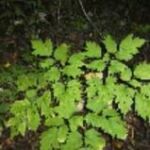| Drug Interactions: |
| Taking black cohosh with these drugs may increase the risk of hypotension (excessively low blood pressure): |
| Acebutolol, (Sectral) |
Amlodipine, (Norvasc) |
Atenolol, (Apo-Atenol, Tenormin) |
Benazepril, (Lotensin) |
Betaxolol, (Betoptic S, Kerlone) |
| Bisoprolol, (Monocor, Zebeta) |
Bumetanide, (Bumex, Burinex) |
Candesartan, (Atacand) |
Captopril, (Capoten, Novo-Captopril) |
Carteolol, (Cartrol, Ocupress) |
| Carvedilol, (Coreg) |
Chlorothiazide, (Diuril) |
Chlorthalidone, (Apo-Chlorthalidone, Thalitone) |
Clonidine, (Catapres, Duraclon) |
Diazoxide, (Hyperstat, Proglycem) |
| Diltiazem, (Cardizem, Tiazac) |
Doxazosin, (Alti-Doxazosin, Cardura) |
Enalapril, (Vasotec) |
Eplerenone, (Inspra) |
Eprosartan, (Teveten) |
| Esmolol, (Brevibloc) |
Felodipine, (Plendil, Renedil) |
Fenoldopram, (Corlopam) |
Fosinopril, (Monopril) |
Furosemide, (Apo-Furosemide, Lasix) |
| Guanabenz, (Wytensin) |
Guanadrel, (Hylorel) |
Guanfacine, (Tenex) |
Hydralazine, (Apresoline, Novo-Hylazin) |
Hydrochlorothiazide, (Apo-Hydro, Microzide) |
| Hydrochlorothiazide and Triamterene, (Dyazide, Maxzide) |
Indapamide, (Lozol, Nu-Indapamide) |
Irbesartan, (Avapro) |
Isradipine, (DynaCirc) |
Labetalol, (Normodyne, Trandate) |
| Lisinopril, (Prinivil, Zestril) |
Losartan, (Cozaar) |
Mecamylamine, (Inversine) |
Mefruside, (Baycaron) |
Methyclothiazide, (Aquatensen, Enduron) |
| Methyldopa, (Apo-Methyldopa, Nu-Medopa) |
Metolazone, (Mykrox, Zaroxolyn) |
Metoprolol, (Betaloc, Lopressor) |
Minoxidil, (Loniten, Rogaine) |
Moexipril, (Univasc) |
| Nadolol, (Apo-Nadol, Corgard) |
Nicardipine, (Cardene) |
Nifedipine, (Adalat CC, Procardia) |
Nisoldipine, (Sular) |
Nitroglycerin, (Minitran, Nitro-Dur) |
| Nitroprusside, (Nipride, Nitropress) |
Olmesartan, (Benicar) |
Oxprenolol, (Slow-Trasicor, Trasicor) |
Perindopril Erbumine, (Aceon, Coversyl) |
Phenoxybenzamine, (Dibenzyline) |
| Phentolamine, (Regitine, Rogitine) |
Pindolol, (Apo-Pindol, Novo-Pindol) |
Polythiazide, (Renese) |
Prazosin, (Minipress, Nu-Prazo) |
Propranolol, (Inderal, InnoPran XL) |
| Quinapril, (Accupril) |
Ramipril, (Altace) |
Reserpine, (Reserpine) |
Sildenafil, (Viagra) |
Sotalol, (Betapace, Sorine) |
| Spironolactone, (Aldactone, Novo-Spiroton) |
Telmisartan, (Micardis) |
Terazosin, (Alti-Terazosin, Hytrin) |
Timolol, (Betimol, Timoptic) |
Torsemide, (Demadex) |
| Trandolapril, (Mavik) |
Triamterene, (Dyrenium) |
Trichlormethiazide, (Metatensin, Naqua) |
Valsartan, (Diovan) |
Verapamil, (Calan, Isoptin SR) |
| Taking black cohosh with these drugs may alter/interfere with the action of the drug and is best avoided by those with estrogen-dependent tumors: |
| Anastrozole, (Arimidex) |
Carbocysteine, (Mucopront, Rhinatiol) |
Cisplatin, (Platinol-AQ) |
Cyclophosphamide, (Cytoxan, Neosar) |
| Cyproterone and Ethinyl Estradiol, (Diane-35) |
Doxorubicin, (Adriamycin, Rubex) |
Epirubicin, (Ellence, Pharmorubicin) |
Estradiol, (Climara, Estrace) |
| Estrogens (Conjugated A/Synthetic), (Cenestin) |
Estrogens (Conjugated/equine), (Cenestin, Premarin) |
Estrogens (Esterified), (Estratab, Menest) |
Estropipate, (Ogen, Ortho-Est) |
| Ethinyl Estradiol, (Estinyl) |
Ethinyl Estradiol and Ethynodiol Diacetate, (Demulen, Zovia) |
Ethinyl Estradiol and Etonogestrel, (NuvaRing) |
Ethinyl Estradiol and Levonorgestrel, (Alesse, Triphasil) |
| Ethinyl Estradiol and Norenthindrone, (Brevicon, Ortho-Novum) |
Ethinyl Estradiol and Norgestimate, (Cyclen, Ortho Tri-Cyclen) |
Ethinyl Estradiol and Norgestrel, (Cryselle, Ovral) |
Exemestane, (Aromasin) |
| Fluorouracil, (Adrucil, Efudex) |
Megestrol, (Lin-Megestrol, Megace) |
Mitomycin, (Mutamycin) |
Mitoxantrone, (Novantrone) |
| Norgestrel, (Ovrette) |
Paclitaxel, (Onxol, Taxol) |
Tamoxifen, (Nolvadex, Tamofen) |
Thiotepa, (Thioplex) |
| Vinblastine, (Velban) |
| Taking black cohosh with these drugs may reduce or prevent drug absorption: |
| Ferric Gluconate, (Ferrlecit) |
Ferrous Fumarate, (Femiron, Feostat) |
Ferrous Gluconate, (Fergon, Novo-Ferrogluc) |
| Ferrous Sulfate, (Feratab, Fer-Iron) |
Ferrous Sulfate and Ascorbic Acid, (Fero-Grad 500, Vitelle Irospan) |
Iron-Dextran Complex, (Dexferrum, INFeD) |
| Polysaccharide-Iron Complex, (Hytinic, Niferex) |
|

